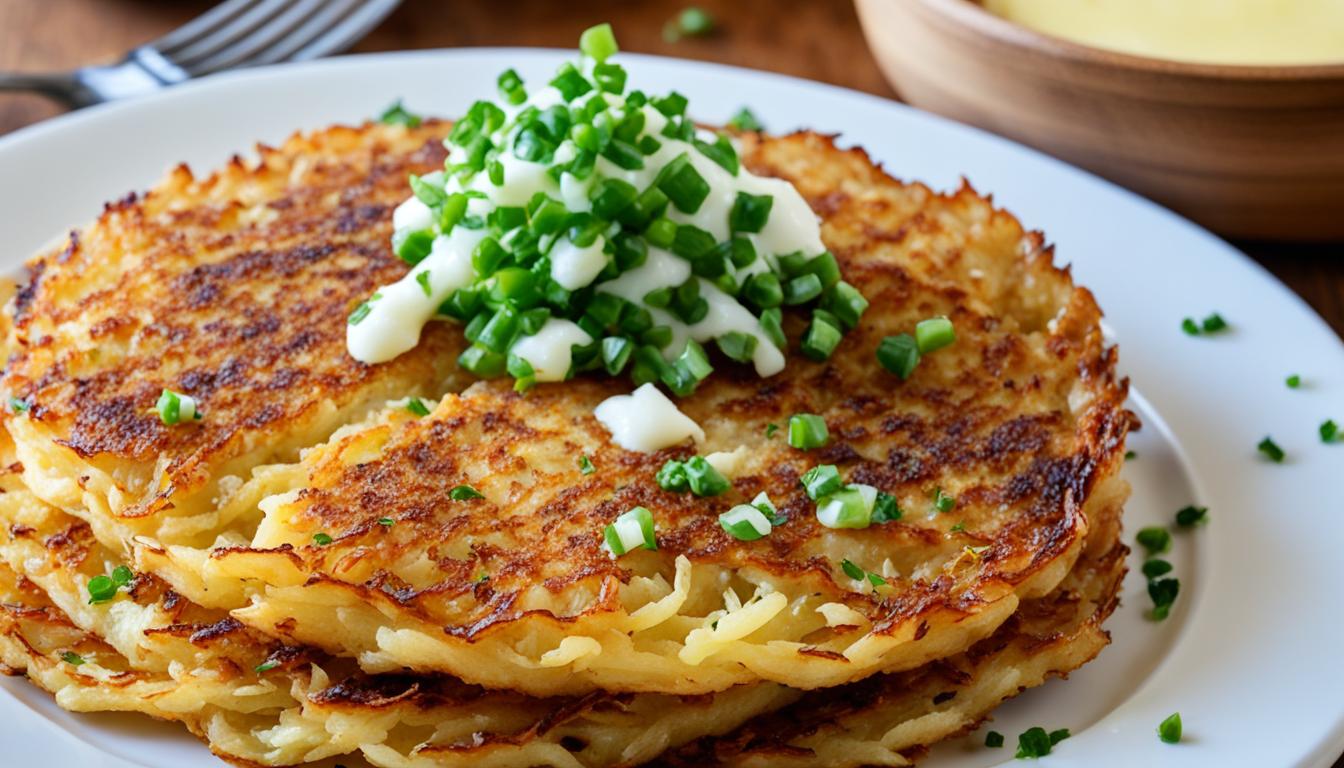When it comes to comfort food, few dishes can beat the classic Swiss favorite — rosti. Whether you’re craving a hearty breakfast or a satisfying dinner, rosti never fails to deliver. But what makes the perfect rosti? And how can you achieve that irresistible golden crispiness? We’ve got you covered with a foolproof recipe that will have you serving up delicious rosti in no time.
So, are you ready to become a master of the rosti? Let’s dive in and uncover the secrets to creating the best homemade version of this traditional dish. Get your apron on and prepare your taste buds for a mouthwatering experience!
Before we reveal the secrets of our perfect rosti, let’s start with the basics. What exactly is rosti? This delightful Swiss dish is made from grated potatoes that are cooked until crispy on the outside and tender on the inside. It’s simple yet satisfying, and can be enjoyed on its own or paired with a variety of ingredients to create a complete meal.
Now, let’s address the big question: Is it possible for homemade rosti to rival the authentic Swiss version? Can you recreate that restaurant-quality crispiness in your own kitchen? The answer is an emphatic YES! With our easy rosti recipe, you’ll be amazed at how simple it is to achieve that perfect texture and mouthwatering flavor.
Stay tuned as we guide you through each step of the process, from selecting the right potatoes to mastering the flipping technique. By the end, you’ll be confident in your ability to create the best rosti you’ve ever tasted. So, let’s roll up our sleeves and get cooking!
Choosing the Right Potatoes for Rosti
The choice of potatoes used in the rosti recipe can greatly influence the texture and taste of the dish. To achieve the perfect rosti, it is important to select the right potatoes that complement the flavors and provide the desired mouthfeel.
When it comes to rosti, waxy potatoes such as white potatoes and Yukon Gold are the preferred options. These potatoes have a higher moisture content and lower starch content, which makes them hold their shape better during cooking. When grated, waxy potatoes create distinct strands that contribute to the traditional texture of rosti.
Alternatively, floury potatoes can also be used for rosti. However, it should be noted that floury potatoes will result in a slightly fluffier interior, resembling mashed potatoes. This can be a good option for those who prefer a softer and more melt-in-your-mouth experience.
When shopping for the ingredients, it is recommended to specifically look for waxy potatoes like white potatoes or Yukon Gold. These varieties have the ideal characteristics to ensure a successful rosti.
In order to achieve the desired texture, it is advisable to parboil the potatoes the day before making the rosti. This process helps draw out some of the starch and moisture from the potatoes, allowing for a crispier and more evenly cooked final dish.
During the parboiling process, it is possible to leave the skin on the potatoes. This not only saves time but also adds a touch of rustic appeal to the rosti. Before grating, the skin can be easily scraped off with a butter knife, ensuring a cleaner and smoother texture.
While grating the potatoes, consider grating them lengthwise to create longer strands. This can result in a more visually appealing presentation, but do keep in mind that the length of the strands does not significantly impact the overall taste and texture of the rosti.
Choosing the right potatoes is a crucial step in the rosti-making process. Whether you opt for waxy potatoes like white potatoes or Yukon Gold, or decide to use floury potatoes for a fluffier rosti, the selection will greatly affect the outcome of the dish. Experiment with different potato varieties to find your perfect rosti, and enjoy the delectable combination of crispy exterior and tender interior.
Tips for Making the Perfect Crispy Rosti
When it comes to achieving the perfect crispy rosti, there are a few key tips and techniques to keep in mind. First, using clarified butter or ghee as the cooking fat can significantly enhance both the flavor and crispiness of the dish. Clarified butter, which is made by removing the water and milk solids from regular butter, has a higher smoke point and imparts a more intense buttery taste to the rosti. If you don’t have clarified butter on hand, you can achieve a similar effect by using a combination of regular butter and oil.
The flipping technique is another crucial aspect of making a successful rosti. To flip the rosti without breaking it, we recommend using a wooden board or a plate with a handle to cover the skillet, and then quickly flipping the entire pan over. This method helps to ensure that the rosti maintains its shape and doesn’t fall apart during the flipping process.
Monitoring the color of the rosti while cooking is important to achieve a golden and crispy exterior without burning. Adjust the heat as necessary to maintain an even cooking temperature. Additionally, making individual-sized rosti instead of one large one can result in an even crispier texture.
For the best eating experience, serve the rosti immediately after cooking to maintain its crispiness. The rosti can be enjoyed on its own or paired with a variety of ingredients, such as schnitzel, roast chicken, bacon, eggs, cheese, onions, applesauce, or horseradish, to create a complete and satisfying meal.
If you’re looking for visual guidance, you can find a helpful recipe video in one of our sources, which demonstrates the step-by-step process of making rosti. With these tips and techniques, you’ll be well on your way to creating the perfect crispy and delicious rosti at home.
